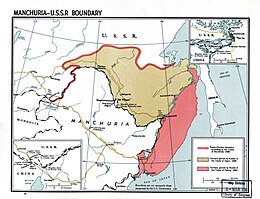
Back Anexión de Amur Spanish Annexion de la rive gauche de l'Amour French Aneksasi Amur ID Amur Annexation IG 아무르 병합 Korean Anexação de Amur Portuguese Присоединение Приамурья и Приморья к России Russian Приєднання Приамур'я і Примор'я до Росії Ukrainian 兼并阿穆尔 Chinese

Between 1858 and 1860, the Russian Empire annexed territories adjoining the Amur River belonging to the Chinese Qing dynasty through the imposition of unequal treaties. The 1858 Treaty of Aigun, signed by the general Nikolay Muravyov representing the Russian Empire and the official Yishan representing Qing China, ceded Priamurye—a territory stretching from the Amur River north to the Stanovoy Mountains, but the Qing government initially refused to recognize the treaty's validity. Two years later, the Second Opium War concluded with the Convention of Peking, which affirmed the previous treaty as well as an additional cession including the entire Pacific coast to the Korean border, as well as the island of Sakhalin to Russia. These two territories roughly correspond to modern-day Amur Oblast and Primorsky Krai, respectively. Collectively, they are often referred to as Outer Manchuria, part of the greater region of Manchuria.[1]